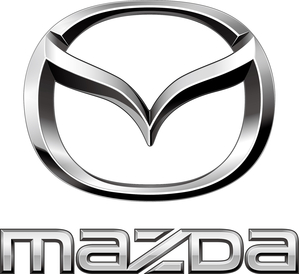Mazda TAKERI Concept Makes North American Debut in New York
Concept Car Features KODO Design, Full Suite of SKYACTIV®[1] Technologies
NEW YORK, April 2, 2012 /PRNewswire/ -- Mazda's TAKERI Concept will make its North American debut at this week's 2012 New York International Auto Show, and is the brand's first concept vehicle to feature the SKYACTIV-D clean diesel engine as well as other revolutionary Mazda-developed, fuel-saving technologies such as i-stop, a stop-start system, and i-ELOOP, a regenerative braking system. TAKERI is the third concept vehicle borne of the KODO ("Soul of Motion") design language and the second to feature the full suite of SKYACTIV components.
First introduced on the SHINARI Concept, KODO has produced elegantly powerful concept vehicle designs that have developed into equally handsome production cars, such as last year's MINAGI Concept, a compact crossover SUV that became the basis of the all-new, award-winning 2013 CX-5. The sharp features of TAKERI also could undoubtedly make their way into a future production vehicle.
Designed to Deliver
The TAKERI Concept's name is derived from the Japanese word meaning "male," fittingly matching the vehicle's masculine manner. Its KODO design elements are easy to identify and are uniquely Mazda, first with the brand's new family face in its sharp five-point grille and lean, chiseled front fascia to the pronounced body lines which swiftly slice into TAKERI's steel frame to create katana-like strokes, evoking a tempered intensity. Stressing aerodynamic performance into shapely design, TAKERI's sculptured shape carries through the vehicle's four-door torso and into the strong rear fender hip lines and taut trunk layout. With a bold metallic-red finish and 20-inch satin-chrome alloy wheels, TAKERI is a vehicle with striking emotional appeal, unseen and unrivaled in the current mid-size sedan segment.
Elegant simplicity begets TAKERI's interior cabin. The cockpit features a perfected balancing act of functionality, luxury and comfort. Satin chrome is used selectively and purposefully throughout the striking, mostly-black instrument panel. From control dials and door panel features to the in-dash navigation system frame and three-spoke steering wheel, the metallic sheen creates a sense of depth and quality, particularly when struck by natural light. A SKYACTIV-Drive six-speed automatic is complemented by racing-inspired paddle shifters and alloy pedals. Plush ceramic white leather seats add the final piece of cabin comfort and feature securing side bolsters that remind driver and passenger alike of the Zoom-Zoom performance machine that lies beneath the spoiling pamper of interior amenities.
The Continuing Evolution of SKYACTIV TECHNOLOGY
SKYACTIV TECHNOLOGY is Mazda's umbrella term for its far-reaching, revolutionary engineering philosophy which focuses on developing affordable, fuel-efficient vehicles without sacrificing performance and the overall joy of driving. TAKERI is the second concept vehicle to be outfitted with Mazda's full suite of SKYACTIV components – transmission, engine, body and chassis – but is the first concept to feature the SKYACTIV-D 2.2-liter clean diesel engine.
At 14.0:1, SKYACTIV-D boasts the world's lowest compression ratio for a diesel engine. Offering a high amount of torque as well as cleaner combustion, the SKYACTIV-D 2.2-liter is 10 percent lighter than the current MZR-CD 2.2-liter diesel engine, reduces internal engine friction by 20 percent and improves fuel economy by 20 percent. This is achieved by using a new two-stage turbocharger, which delivers a smooth and steady response across the engine range (up to 5,200 rpm), as well as optimizing the engine's combustion timing. The low compression ratio also means the SKYACTIV-D diesel engine burns cleaner and discharges fewer nitrogen oxides to produce virtually no soot, thus requiring no additional NOx aftertreaments, which is typical of conventional diesel engines.
With the most stringent of emissions standards met, TAKERI's focus moves to exceeding fuel economy expectations. Additional fuel-saving technologies come in the form of Mazda's redeveloped "i-stop" idling stop system and first-ever "i-ELOOP" regenerative braking system.
i-stop was uniquely developed for the SKYACTIV-D diesel engine and achieves the world's fastest diesel engine restart at less than 0.4 seconds. Other diesel engine stop-start systems require two engine cycles to restart combustion, however, i-stop was engineered to use only a single engine cycle through careful positioning of the pistons as the engine stops. The accelerated restart equates to a smoother, barely noticeable pick-up as well as significant improvement in stop-and-go fuel economy.
Another Mazda-engineered system for increased fuel efficiency is the all-new i-ELOOP, which is the world's first capacitor-based regenerative braking system. In real-world driving conditions which feature frequent acceleration and braking, i-ELOOP, a name derived from "Intelligent Energy Loop," will improve fuel economy by up to 10 percent. A growing segment in fuel-saving technology, regenerative braking systems use an electric motor or alternator to generate electricity as the vehicle decelerates, thereby recovering a portion of the vehicle's kinetic energy. Such systems used in hybrid vehicles typically use a large electric motor and a dedicated battery.
With i-ELOOP, however, through the use of a capacitor, which is an electrical component that temporarily stores large volumes of electricity, the system avoids the need for a dedicated electrical motor and battery. Capacitors have the ability to charge and discharge rapidly and are resistant to deterioration through prolonged use. The i-ELOOP system efficiently converts the vehicle's kinetic energy into electricity as it decelerates and uses the electricity to power the climate control, audio system and numerous other electrical components. i-ELOOP features a new 12-25V variable voltage alternator, a low-resistance electric double-layer capacitor and a DC-to-DC converter.
The i-stop stop-start system is currently available in vehicles sold in Japan, Europe, Australia and New Zealand. The i-ELOOP regenerative braking system will be introduced into Mazda vehicles beginning in 2012. Markets and models will be announced at a later date.
Mazda North American Operations is headquartered in Irvine, Calif., and oversees the sales, marketing, parts and customer service support of Mazda vehicles in the United States and Mexico through nearly 700 dealers. Operations in Mexico are handled by Mazda Motor de Mexico in Mexico City. For more information on Mazda vehicles, visit the online Mazda media center at www.mazdausamedia.com. Product B-roll may be ordered online by visiting The News Market at www.thenewsmarket.com/mazda.
[1] SKYACTIV is a registered trademark of Mazda Motor Corporation (MC).
SOURCE Mazda North American Operations
WANT YOUR COMPANY'S NEWS FEATURED ON PRNEWSWIRE.COM?
Newsrooms &
Influencers
Digital Media
Outlets
Journalists
Opted In






Share this article